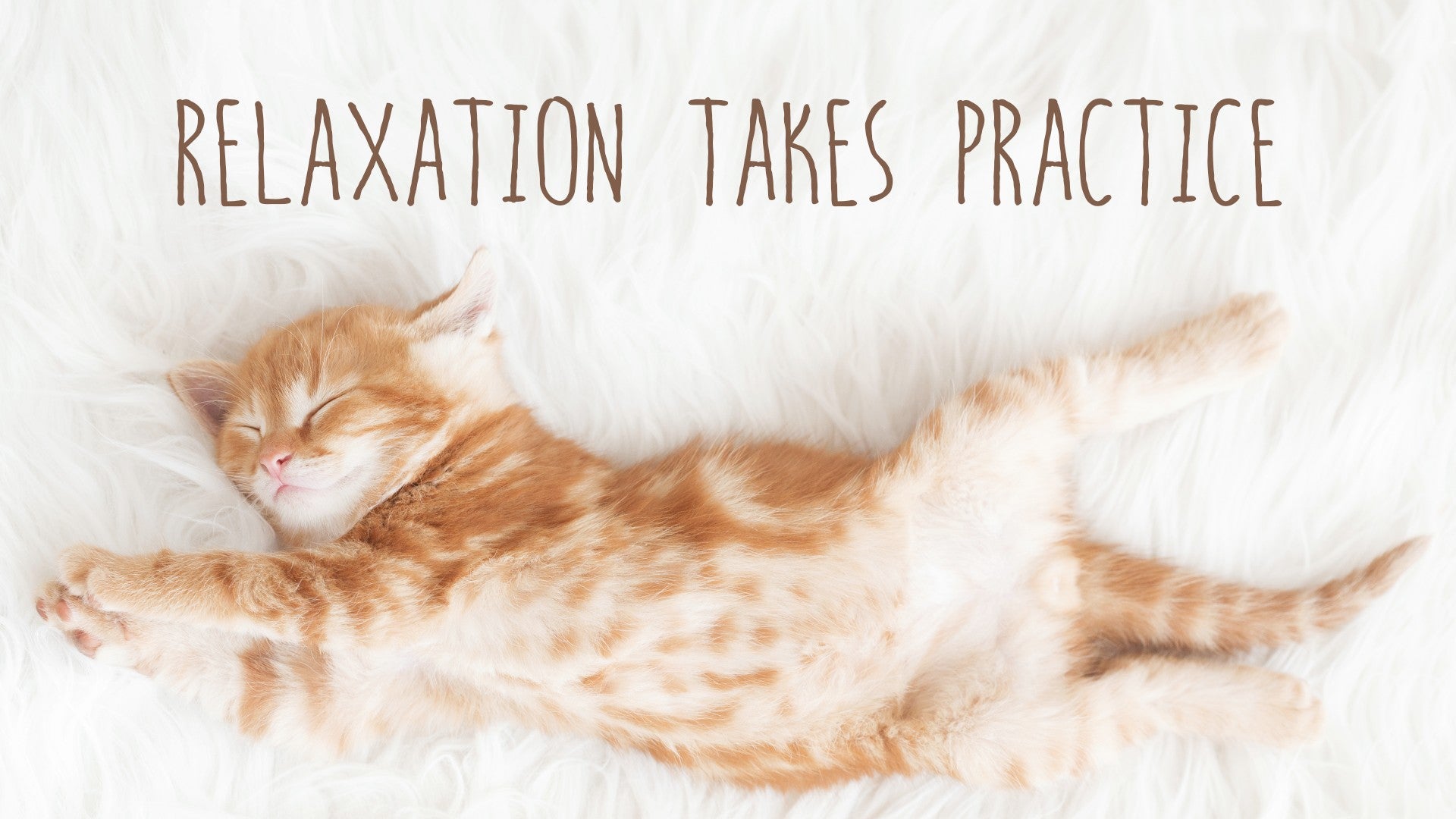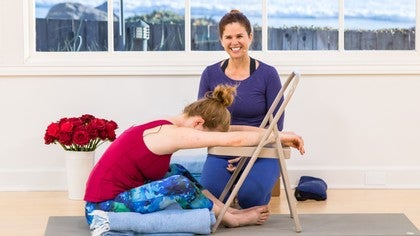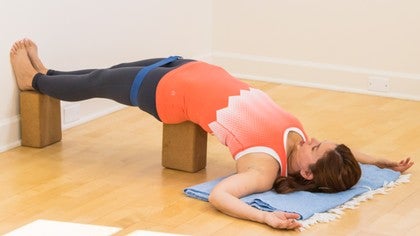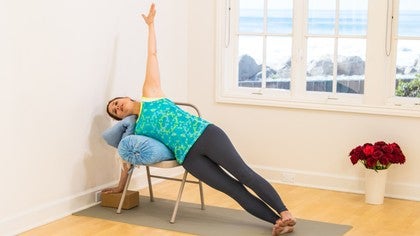Description
About This Video
Transcript
Read Full Transcript
(waves gently crashing) Hi, everyone. Welcome to Yoga Anytime. So, I'm here today with Hailey, and she's gonna help us help you, how to be in restorative yoga, in the poses as most comfortable as you can be. The question that I get a lot of the time is, well, how do I know how to use the props, and if I follow the teacher along, like, maybe it's not so comfortable. How do I move, then?
How do I strategically place the props so that it's good for me? And that's pretty much what we're gonna do today. Hailey is going to help us demonstrate Baddha Konasana, which is bound angle pose. And the reason I've chosen that pose is it's a pose that I know a lot of students do sort of suffer with. Some people really love being in it, but there's this large percentage of people that may be not so comfortable in it.
And I wanna show you the different options and why you would use specific option. There are really four sort of keys to figuring out this whole piece of strategically placing the props. The first one is really honoring the pose classification. Pose classification meaning that it's either a standing pose, or a forward bend, or a back bend, or a twist, or an inversion. And, in this case, we can kind of look at Baddha Konasana as a standing pose, even though we're not on the feet.
It's a lot like warrior two, right? It's external rotation of both of the legs. So there's a big inner thigh stretch that we're getting. The next thing to do, and the way to do that, actually, the way to honor that pose classification, is either to fill the space, meaning that there's daylight between the floor and your body, right? We're filling that space so it's real cozy when you're in the pose.
Another way to do that is to reduce the reach. We don't want Hailey to have to try to catch the pose, like to try to find it. We wanna bring the pose to her, and sometimes that will be reducing the reach so she doesn't have to chase after it. And when I say chase, this is really important, it's not just chase the shape, it's also chase the sensation. In restorative yoga, there's no chasing of sensations, whatsoever.
The next thing is, sometimes, we need to broaden the base, we need to make the base of the pose a little bit better so it's a little more accessible. So these are the things that we're gonna deal with with you today, Hailey, in Baddha Konasana. So I'm gonna actually have her just sit in Baddha Konasana for one second, with the soles of the feet. If you happen to be someone who sits in the pose, before you even get any props, and you notice that the knees are maybe a little higher than the hip level, they're not in the same plane, and the feet are forward, it's all good. What we need to remember is that Hailey's perfect, she's absolutely perfect as she is.
This is one of the pieces that I think we should really start with first is recognizing that our students absolutely are perfect, and what we wanna do, is we just wanna meet them where they are. So how we're gonna do that is we're gonna address this issue here of the knee being a little higher. And why do we care about it? Well, we care about it 'cause in restorative yoga, we're in the poses a little longer. We're not in 'em for five or 10 breaths.
We're in 'em from two to three to four, sometimes five and six minutes, so it needs to be comfortable. She needs to feel as though, okay, I can be in this for two or three minutes. It's one of the questions that I'll ask her when we play with the different variations. So the first one that we're gonna do is probably reduce the reach, Hailey. So what I'm gonna do, is I'm gonna have you sit over here, facing this wall here, and I'm gonna take the chair and bring it in front of you.
And the first thing you're gonna do is just put your hand right on the seat of the chair, get a little bit of length. And I'd like you to get as close to the chair as you comfortably can, and what I'm watching is I'm watching her knees. I'm watching to see if, as she comes forward, he knees actually lift. OK, so, they didn't so much. But I wanna reduce the reach a little bit more, so I wanna bring the chair a little closer to her.
So come on up. I'm gonna bring that chair a little closer to her, and I'm also gonna do one other thing. I'm actually going to take some support with blankets, roll 'em up, and put 'em right underneath her top thighs. Now, the question is, well, could I just put 'em anywhere? Could I put 'em underneath the knees?
You could, but the idea is to put 'em where the heaviest part of the leg is. So we're gonna put it at the very tops of the thighs. I'm gonna take this blanket, and roll it up, and place it here. How's it feel? Much better.
(laughs) Good answer! (laughs) Okay. And do you mind, Hailey, just putting that right underneath? Good. Got it? Perfect, there it is.
Okay. So just how she does, like she kind of nestles herself in there. Good, so it's a natural instinct when it feels right, it's like I want it to feel just right. Okay, so go ahead and place your hands. Get a little bit of length first, and then come on forward just like you did before.
Okay, how's it feel?
My left side is a little tight there, I think. This side, the right side less?
You do, okay. (laughs) Okay, so this is the thing about restorative yoga, also, right? There's a really important word. The word is wait. (laughs) And the reason why that is so important, is that it takes a little bit of time for the pose to come to you. Even though, we brought it to you physically, the sensations take a few moments.
So, when someone says, well, I'm not feeling anything right away, or what am I supposed to feel, when am I supposed to feel it, we kind of have to set it up and then wait a moment. So I'd like you to wait for about 20 seconds, okay? So bring your head down. Relax your shoulders. Mm-hmm.
There you go. So now she's breathing. (laughs) Let the weight of the hips release. And then, I'm gonna check in with you in about another 20 seconds. But, if in that time, it feels like you need less or more support, then let me know. Go ahead and take the breath that you're on and take one more full breath.
I'd like you to stay where you are. If I asked you to stay another minute, do you think that you could, and it would be comfortable?
So, was there any sensation that was starting to percolate? I felt like I maybe wanted a little less support on the right, and a little bit more on the left. So this is really common, right, 'cause we have these imbalances in our body. One side is tighter than the other. So it's okay to adjust that.
When the teacher says, or you watch one of our videos, and we say, okay, put both of the blankets here, pay attention to what's happening. We're waiting, and then as we're waiting, things are starting to shift and change. And then what we would do is we modify. We get rid of something, we put something else in, whatever. You'll find that even as you stay, if I were to have her stay for another full minute, right, that that may change again.
You may go, it might go, oh, I can let it go a little bit more, you know? We don't really know until we're in it for a little bit. Okay, so reducing the reach is bringing more of the pose to you. And the pose, what we're thinking about is the pose is actually the props. 'Cause the props are what making the pose.
I mean, obviously you're making the pose, too, right? But the props are what make the pose restorative. Let's show what broadening the base might look like. I'm gonna move this chair out of the way, and slide these blankets out of the way. And here she is in her Baddha Konasana.
And what I'm gonna do right now is have her pull her feet in really close. And you can see that, at this point, the knees get even a little bit higher, unless she uses leverage, right, here, to push her top thighs down, which she's totally capable of doing. But it's not the stretch that we're looking for in restorative yoga. So broadening the base in this instance, is gonna have two things. One this is the feet are gonna go out where you had before.
And we're gonna let 'em go all the way out until those knees get a little closer in the same plane. So before, right, the knees were still a little elevated. So this is now broadening the base. If when she comes to move forward again, we're gonna test it with the reduce the reach, that she has absolutely nothing here, and she maybe wants just a little bit of sensation, then we can do this. We can take a block and bring it between the feet.
And when she actually comes forward, she'll feel a little bit more of that sensation between the inner thighs. So I'm gonna take the chair, and I'm gonna try something different, actually. I'm gonna move the chair so that the back of the chair faces her. And what I'd like you to do, I know this isn't gonna slide perfectly, but just put your hands on the top of the chair, push it forward a little bit. Good, hold it right there for just a moment.
How does it feel? It feels okay on the right side. The left side, I feel like I'm gripping, or tight, here. My left ankle is kind of-- Kind of funky? Yeah.
So let's do this. Let's pull yourself in a little bit more, those feet, a little closer. Let me know if that changes that. Did it make it worse or better? It did make it better.
Okay, alright, so it was a little too far out. So now we're at reducing the reach, which meaning that we brought the chair a little closer to her because what we're interested in is the spine, as well. We don't want to see that lower back rounding. We want to see it lengthening as much as possible. And then we also broaden the base here, so that she could get a little bit of stretch in the inner thighs.
Okay, come on up. Let's see what happens if you bring it all the way into you, and if it's the most comfortable. I'm actually going to put one more blanket on top of this, just to reduce the reach a smidge more. And you're just gonna place your head right there, Hailey, and hang on to these lower. Mm-hmm.
Let me know what that's like. Very little sensation, is what we're looking for. Yeah, I don't feel a whole lot on my inner thighs. If anything, it's just a little bit on the outside of that, yeah. Okay, so come on up.
But other than that, it's quite comfortable. So now we get to the next thing which is filling the space, which we showed a little while ago, right, with both of the blankets. If she's still feeling it on the left side, there is that space, you can't see it, right, but it's this space here. So we would fill that space with some support. Let me know if that makes a difference.
Yeah, that helps a lot. Okay, there's another thing that you could actually do. And do you mind testing it? Nope, not at all. So stay where you are.
I'm actually gonna let this go. Mmm? No, I have another thought. I'm gonna keep it there, and I'm gonna add this. First I thought maybe I would just take the support of the bag, but let's do both.
I'm gonna put this right at that top thigh. So when it grips, it means, right, that it's trying to hold itself so it's not letting go. And if you put some weight and we also fill this space, I'm just curious to see what might happen. So come on forward, and let me know. And we're looking to see if the gripping goes, and if the bag changed that in any way.
Yeah, the gripping's almost totally gone now, I think. Yeah, that feels a lot better. Okay, so, when we get tightness in these inner thighs, or in this particular position, right, Baddha Konasana, again, the classification, it is really like a standing pose. We need the lower body to ground, and this is what the bag does. So now there's no resistance that's happening, and I suspect that if we let her go for another minute, she'd probably be okay.
Okay, go ahead and come on out. Awesome. So that is what you're looking to do. You're looking to either bring more of the pose to you, you can come out and relax, Hailey. Bring more of the pose to you, fill some space between where your body is and where the floor is, or reduce the reach we did, or broaden the base.
Which means that we're making the base of the pose, the foundation of the pose, bigger. Those three things, as well as having some curiosity in your student, knowing that they really are perfect as they are, meeting them exactly where they are. I really think it's like the most loving thing that we can do, is to meet someone where they are, not force 'em to go where they're not ready to go or to grow. So if you're practicing on the mat, and you're watching all of the yoga videos, and you hear your teacher tell you to get a block and put it this way, or a chair or a mat, or whatever it is, just know that you can explore at your own pace. And that, just because we tell you to get these things and put them in this way, may not actually be the way that works for you.
What you need to really pay attention to is these four things, the pose classification, what is the architecture of the pose, what is the shape of the pose that we're trying to be in. The next thing is the reduce the reach, which is bringing more of the pose to the student, with the props. The third thing would be to broaden the base, and making sure that the base is big enough so that there's room for you to go forward, or room for you to reach, or room for you to turn. And then the last thing would be to fill the space, to make sure that the distance between, and let me just say that I didn't say before. This is important, that filling the space piece is important, especially with someone who has some kind of injuries in the joints, like the hips, the knees, or the shoulders.
When you fill the space you take the load of gravity away, right, and you really soften it. So now the center of gravity changes in the pose. And so, when the arm has nothing underneath it, the brain gets a little, uh-ah, what do we do, and the nervous system starts to fire. And what we're really trying to do is calm that nervous system down. So when we fill that space, now the body gets some feedback, and the nervous system goes, oh, okay, yeah, I can relax.
I can soften into this. So, follow those four things and I think you'll do okay. Thank you so much for joining us today. Namaste.
Relaxation Takes Practice
Comments
My perspective is to meet "individual and unique" needs rather than a one size fits all solution as in the long run of a practice, it never really wakes up con solidness in the areas that are dull, weak, or tight. I hope this information has been helpful to you and I greatly appreciate you opening up he conversation. Brilliant!
You need to be a subscriber to post a comment.
Please Log In or Create an Account to start your free trial.













